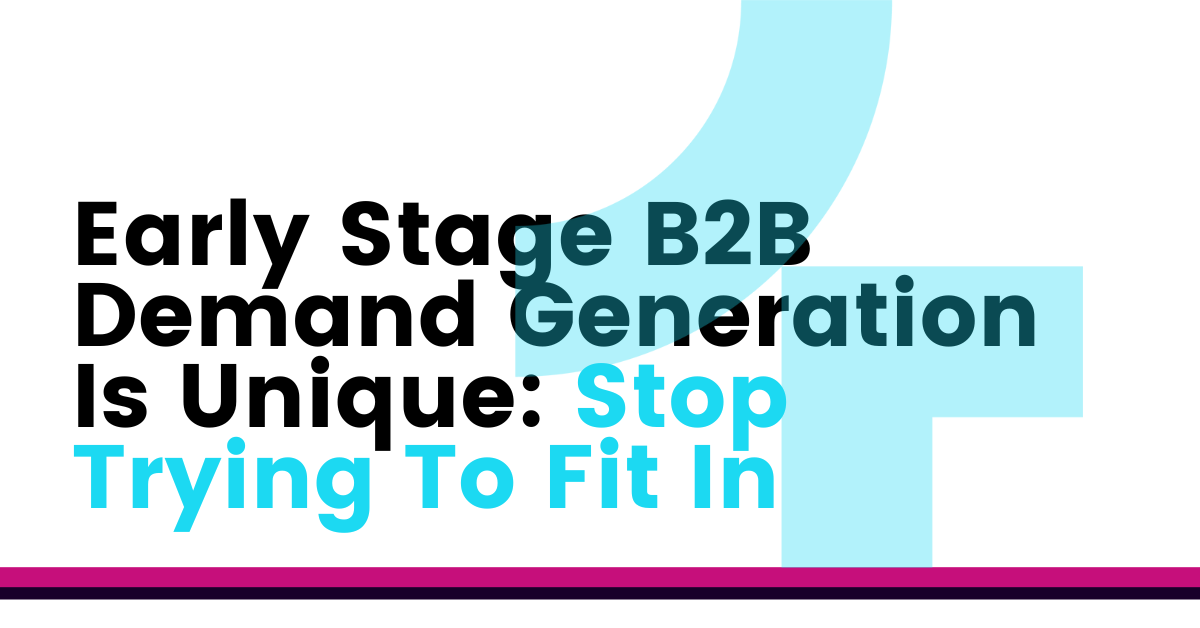

In early stage B2B demand gen, you don’t have to do everything all at once. Simplify!
You don’t have to do what all the marketing gurus out there are telling you are best practice. For example, lead scoring may not be right for you if you only have a few customers and just a trickle of incoming leads. But time and time again, we see lead scoring implemented because conventional wisdom says that it’s the right thing to do for lead quality. In fact, in early stage B2B demand gen, any lead that has the right title at the right type of company probably deserves nurturing and follow up. At this point, you need to start building your database — and that new unscored lead is perfect for you right now.
The things you need to get right…
Who is your ICP?
If you’re asking what an ICP is, it’s an Ideal Customer Profile, and it’s important to think about and understand who that is and what your ideal customers look like. Not what color their hair is, but what matters to them and why. Your ICP is your most valuable customers and prospects — the ones most likely to buy from you.
Is your website set up for success?
Believe it or not, it’s not enough to just have a website. You need to think of it as a lead generation engine. To do that, you need to have a clear call to action (CTA). Do you want them to call you? Is it obvious how to do that and really easy for them to do? Make sure that your website has a clear and consistent CTA so it’s easy for your prospects to take the next step with you.
Are there enough places for a prospect to convert to an interested prospect? If a prospect lands on your website, you need to have content that will draw them in. That means that you need content. And not just content that you’re asking them to give up their personal information for (that’s gated content). You also need to have free content — like blog posts, infographics, and other useful information that’s easy to access.
You also want to make sure that your website speaks to your prospects about their pain and how to alleviate it. They don’t care about you — they care about themselves and how to solve a problem. So, you need to have an offer that is valuable to them and will give them enough information to take next steps. You’re reading this because you’re in the early stages of B2B demand gen, so you might not have any customer quotes yet — but as soon as you do, incorporate them into your website! A quote will let other customers tell your prospects how you’ve solved a problem for them. And when you can, put together a case study so your prospects can learn more about the specific challenges someone solved… using your solution.
If you don’t have quotes or case studies yet, that’s ok! There are other ways at the early stage to communicate your value. As you bring on customers, ask them for a quote or case study. This takes time, so don’t worry if you’re not there yet.
Communicate your value
The first thing you need is enough demand generation content to get started. But don’t just start writing things — make sure your early pieces of content really count. To do that, you need to think about a few things:
What’s your unique point of view (POV)? This is the way your company looks at the world and looks at different situations, and it can give your company and product personality, individuality, and authenticity, which helps your customers and prospects connect with you.
Do you have thought leadership content? The content you produce helps your customers and prospects connect with you — your content should speak with expertise and experience about topics relevant to your business that can help your readers in their roles.
What’s your niche? You can’t be everything for everyone. A niche market is a subset of a larger maker that you can define based on unique needs, preferences, or identity. Speak to your niche audience and they’ll keep coming back for more.
What problem are you solving in the market? This might seem obvious, but you need to talk to potential customers so you can understand their common problems. You should be able to identify some common themes, determine how common the problems are, and whether they’re urgent. You also need to know if your buyers will pay to solve this problem — and then you want to create content that will help them understand how your solution will do just that — and save them time, money, and frustration as well!
Blogs aren’t enough
Lots of companies say they have a ton of content and point to their blog to show how much they are blogging. The truth is: blogging is necessary! It really does help with search engine optimization (SEO) and getting your POV out to the market. Once you get rolling you can use it to feed your PR program and get bylines out in publications that are relevant to your customers and prospects, which is another great way to get them to your website.
But… it’s also important to create more meaty content and videos that you can use to get your audience’s attention. You can publish them in different marketing channels (think LinkedIn, YouTube, Facebook, Instagram, webinars, podcasts, and more), but pay attention to where you get the most traction and focus there. You (still) can’t do everything, so lean into what works! Sometimes the content that you share in those channels should be valuable enough to try to get the prospect to your website — so make sure it’s not all light, obvious fluff. And what that looks like depends on your prospects, so write accordingly. 🙂
What technology do you need to get started?
At the very beginning, you really only need a marketing automation platform and a customer relationship management (CRM) solution. So where should you start investing your marketing dollars?
First, don’t get caught up in your leadership team’s belief that public relations (PR) will help drive sales pipeline, it won’t. Your prospects are not reading your press releases. At the early stage, those press releases are really only for investors or the board of directors, so find a way to do what’s necessary for getting press releases out there without spending a lot.
Focus your spend on where you will learn the most. Initially, that means focusing on content creation and testing your marketing programs. And it might seem obvious, but don’t start spending if you don’t have anyone to follow up with your precious leads! You also need to have a way to nurture a prospect’s interest. Your marketing automation platform can help you do this pretty easily, you just need to make sure it’s integrated with your CRM and everything is set up correctly.
Note: Run for the hills when someone says, “We don’t need a SDR team to follow up on leads, we have a couple sales reps.” Sales reps are not good at following up on leads. They need to focus on moving a prospect through the sales funnel. Think of your business development representatives (SDRs) as a natural extension of the marketing team. Their role is to further qualify the leads that marketing (you!) worked so hard to get in the door.
Process, process, process
For many, process becomes an afterthought and often it’s for good reasons. The emphasis early on is on growth. Hire sales and start the marketing engine with little time spent on developing a clear and consistent lead → opportunity → closed won process. Even with your simplified technology stack mentioned above, you have all the tools you need to develop a world-class process that will give you the critical insights you need to make informed decisions. While this may feel daunting, it’s actually pretty straightforward and relatively simple to put in place.
Here’s a few simple tricks to get you started:
- Capturing lead source: Don't get too complex here. The smaller & more concise the list is, the better. For Example, Event, Webinar, Digital Advertising, etc.
- Utilize lead source detail to understand next level detail around lead source. For example, Event name, Webinar vendor name, digital advertising channel (LinkedIn)
- Ensure that every marketing program you run where dollars are being invested, a campaign is associated with it in HubSpot or SFDC
- Have a clear understanding of how you are capturing Sales Qualified Leads. We like to recommend isolating meetings either by having a 0% meeting stage in the sales stages, or by using activities in your CRM.
Once in place, it will make a world of difference in how your entire team operates. We’ve worked closely with dozens of companies to help them get this process right from the start and for those that implement it and stick with it, they’ve gained a competitive edge.
Want to get it right from the start? Learn how 4AM helps early stage B2B companies test what works and what doesn’t.
We’d love to connect!
Interested in trying the 4AM Platform for free? Create an account and let us know what you think!


